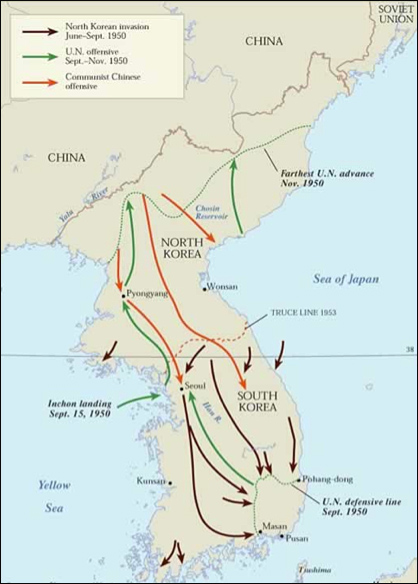Which of the following best explains why the United States did not declare war on North Korea?
A. Because the United States was not attacked by North Korea.
Incorrect. Although the United States' mainland was not attacked, American soldiers fighting under the UN were attacked.
B. The United States participated in the war under the direction of the UN or United Nations.
Correct! The United Nations did enlist the help of member nations including the United States to support South Korea. Thus, the United States was under the direction of the United Nations.
C. If the United States had declared war on North Korea, the Soviet Union would have declared war on the United States.
Incorrect. Although some historians have theorized that this scenario was possible, there is no evidence to prove it.
D. The American people would not have supported the war.
Incorrect. For the most part, Americans did support the “police action” in Korea.
Use the timeline and your knowledge of social studies to answer the following question.

Which title completes the timeline of events for the Korean War?
A. Dwight Eisenhower is elected president.
Incorrect. Eisenhower was elected in 1952 which was after the UN forces were repelled back to South Korea.
B. A truce is signed ending the war.
Incorrect. The timeline represents events of the war. Therefore, a truce or an agreement to end the war does not fit amidst the fighting.
C. The United Nations comes to the assistance of South Korea.
Incorrect. The United Nations came to the assistance of South Korea at the start of the war.
D. China enters the war.
Correct! The Yalu River borders China. Upon the United Nation forces reaching the Yalu River, China did enter the war.
Use the excerpt and your knowledge of social studies to answer the following question.
United Nations Resolution 82-June 25, 1950
Noting with grave concern the armed attack on the Republic of Korea by forces from North Korea, Determines that this action constitutes a breach of the peace; and I
Calls for the immediate cessation of hostilities; II Requests the United Nations Commission on Korea: (b) To observe the withdrawal of North Korean forces to the 38th parallel; (c) To keep the Security Council informed on the execution of this resolution: III Calls upon all Member States to render every assistance to the United Nations in the execution of this resolution and to refrain from giving assistance to the North Korean authorities. |
A. Restore South Korea to a democratic state.
Incorrect. Although South Korea was a democratic country, nothing in this resolution orders the return of democracy.
B. Call upon Member States to render assistance.
Incorrect. Member states are asked to render assistance only to achieve the goal but it is not the actual goal.
C. North Korea to withdraw to the 38th parallel.
Correct! The withdrawal of North Korean forces to the 38th Parallel, along with an end to fighting (hostilities), was the goal of the United Nations.
D. Remain informed on the execution of this resolution.
Incorrect. A special commission on Korea is charged with keeping the United Nations Security Council informed, but their responsibility is not one of the goals of this resolution.
Use the map and your knowledge of social studies to answer the following question.

Several countries are labeled on this map. Which is the only one the United States would call an ally or friend?
A. China
Incorrect. China was a communist nation and the United States opposed communism. The map indicates that China’s offensive routs are against the United States.
B. North Korea
Incorrect. The United States fought North Korea in the Korean War. The North Korean routes are shown against the United States on the map.
C. South Korea
Correct! The United States set up a democratic South Korea following World War II and became allies with that nation; the U.S. offensive routes originate in South Korea where the United States came to the aid of South Korea.
D. Soviet Union
Incorrect. This communist nation was America’s chief enemy throughout the Cold War, but they were not directly involved in the Korean War.